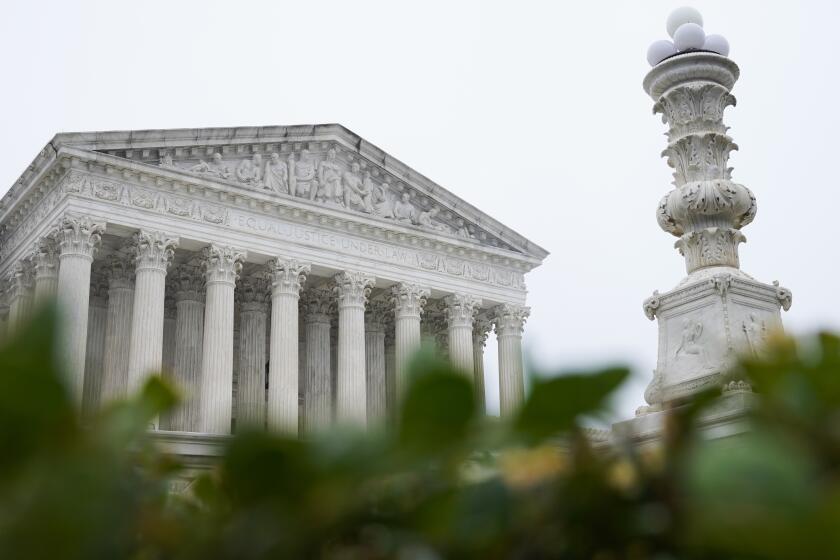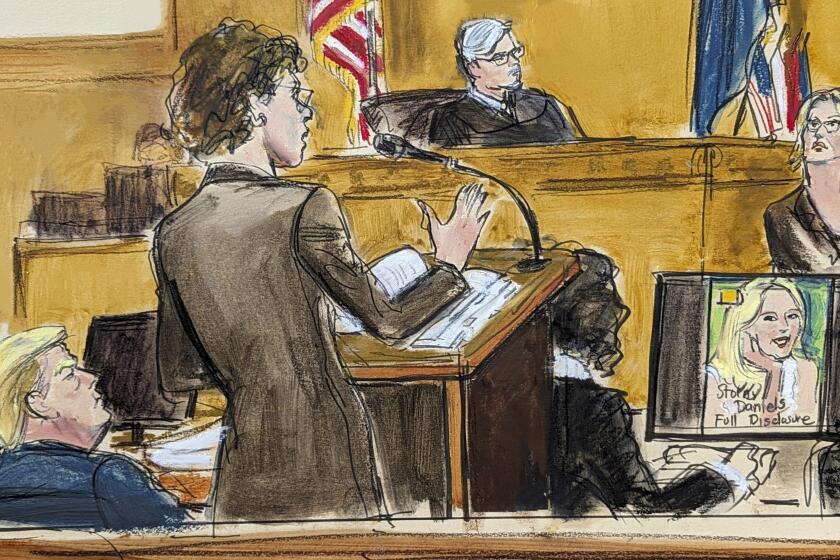The Obscure Nominee : Supreme Court: The selection used to be a very personal decision of the President. Today, politically sensitive advisers do the job.
Far from bold leadership, President George Bush made a cautiously calculated choice in naming Judge David H. Souter to succeed Justice William J. Brennan Jr. The President knows that virtually anyone he might nominate will push the U.S. Supreme Court in even more sharply conservative directions on abortion, affirmative action and a few other issues where Brennan has been able to maintain bare majorities in support of individual rights.
Once again, Bush distanced himself from his popular predecessor by disclaiming that his nominee passed any “litmus test.” Whereas Ronald Reagan made judgeships symbols and instruments of his presidential power, Bush aims to avoid conflict and win reelection. Like other past Republican Presidents in political trouble and confronted with making a tough appointment, Bush appeals to the professionalism of his obscure nominee. In short, Bush punts.
The President, to be sure, contrived to inspire confidence by announcing his choice just three days after Brennan brought to an end 34 years of service on the court. Few Presidents have moved so quickly. Most wait a month or more before announcing their decisions. But Lyndon B. Johnson holds the record for speed: He named his solicitor general, Thurgood Marshall, just a day after Justice Tom C. Clark resigned.
At their own peril, Presidents race ahead before fully checking their nominees’ qualifications and backgrounds. Reagan learned that in 1987, when searching to replace retiring Justice Lewis F. Powell Jr. At the time, Powell was considered pivotal, because he cast the crucial vote for upholding abortion and affirmative-action programs. Unlike Bush, however, Reagan stuck to his ideological guns. After the Senate overwhelmingly rejected his first nominee, Judge Robert H. Bork, the President hastily pressed ahead by naming Judge Douglas H. Ginsburg, instead of the low-key and solidly conservative federal Judge Anthony M. Kennedy. Only when Ginsburg was forced to withdraw, amid revelations that he had smoked marijuana, did Reagan settle on Kennedy.
However swift, Bush’s move also lacks the self-assurance of a Reagan or a Franklin D. Roosevelt. In 1937, F.D.R. retaliated against the court for overturning, by 5-4 votes, much of his New Deal program. He proposed to enlarge the number of justices from nine to 15, thereby securing a majority favorable to him. Then, surprisingly, a justice changed his mind and the court upheld, by a 5-4 margin, major pieces of New Deal legislation. That contributed to the Senate’s defeat of his “court-packing plan,” but F.D.R. remained vindictive and committed to turning the court in new directions. When he got the first of eight chances to fill vacancies, Roosevelt named Sen. Hugo L. Black, who had led the fight for the court expansion and was one of the court’s sharpest critics. Unlike Bush, Roosevelt was not content to “let things happen.”
Bush, moreover, runs the risk that something unexpected about Souter may turn up. He is banking on the investigation conducted by the American Bar Assn. six months ago, when Bush put Souter on the U.S. Court of Appeals for the First Circuit. Souter was rated “well qualified.”
But Richard M. Nixon made that mistake by too quickly jumping to G. Harrold Carswell in 1970. Although sailing through the confirmation process to a seat on the appellate bench, Carswell was roasted in the Senate when shortly after his nomination to the court, certain racist speeches he’d made decades earlier were discovered.
While denying that his nominee is “Bush-league,” the President nevertheless picked a little known (and hence presumably non-controversial) conservative. In passing over more qualified and experienced candidates, he feared the possibility of his and their becoming embroiled in a heated debate over abortion and other emotional social issues.
Nor is Bush the first to adopt such a tactic. John F. Kennedy elevated Arthur J. Goldberg and Byron R. White from within the ranks of his Administration over more qualified jurists. When trying to fill a vacancy in 1930, Herbert H. Hoover picked an ostensibly non-controversial conservative appellate judge, John J. Parker, over the widely respected Benjamin N. Cardozo. But controversy soon erupted over Parker’s record and potential hostility toward blacks and labor. Following Parker’s embarrassing defeat, Hoover was virtually forced to give Cardozo his next appointment.
Souter may indeed offer Bush a politically expedient way of avoiding political conflict. At age 50, single and on the federal bench fewer than four months, he has written no opinions for liberals or conservatives to scrutinize. That was undoubtedly attractive to Bush, but that is not all there is to his nomination.
Souter’s nomination reflects fundamental changes in the politics of judicial selection and of the American presidency. Once the selection of Supreme Court nominees was a very personal decision of the President. That was the practice of presidents in the 19th Century and down through the last appointment to the court by a Democratic President 23 years ago. Winning the presidential nod, as Chief Justice Harlan F. Stone put it, was like winning a “lottery” in which the President handpicked his favorite from a pool of more-or-less qualified individuals. This practice generally worked well, though some of F.D.R.’s and Harry S. Truman’s appointees were not very good. Besides, Presidents at least had personal knowledge of their nominees and how they might reasonably perform on the bench.
With the growth of the institutionalized presidency, however, Presidents have increasingly delegated more responsibility for judicial selection to their subordinates. Not only do their advisers have greater influence; they make politically calculated recommendations on who should be appointed and how a nominee will benefit the President and his party. No Republican President since William H. Taft has been deeply and personally involved in making his nominations to the court.
Bush was no exception. While he only met Souter for the first time just two days before announcing his nomination, Souter had an inside track because of his friendship with the President’s chief of staff, John H. Sununu. As governor of New Hampshire, in 1982, Sununu elevated Souter to that state’s Supreme Court. Last year, Sununu prevailed on Bush to give Souter a seat on the federal appellate bench. With little personal knowledge of his nominee, Bush accepts Sununu’s judgment and asks supporters to again read his lips.
When compared with other Presidents, Bush’s strategy is almost a replay of Gerald R. Ford’s 1975 appointment of Justice John Paul Stevens. Then, as now, the court was poised to change dramatically due to Nixon’s four previous appointments. When William O. Douglas’ seat opened up, the justices were often divided 5-4 or 6-3.
Still, Ford’s advisers were sharply split over who he should appoint. One faction pushed for a woman; another championed Bork. But Ford feared a bitter confirmation battle over a controversial conservative nominee. So he named Stevens, a moderately conservative and relatively unknown federal judge. Women were disappointed and conservatives continue to chafe at Ford’s choice, but Stevens sailed through the confirmation process.
Like Ford and unlike Reagan, Bush passed up an opportunity to make a politically bold and symbolic appointment by naming a woman, a black, a Latino, or a well-known conservative. Clearly, Bush cares more about the short run than the court’s long-term future and its impact on American politics.
More to Read
Get the L.A. Times Politics newsletter
Deeply reported insights into legislation, politics and policy from Sacramento, Washington and beyond. In your inbox three times per week.
You may occasionally receive promotional content from the Los Angeles Times.






